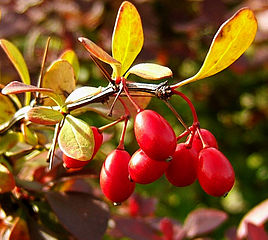
Japanese barberry (Photo by Wildfeuer, Wikimedia Commons)
Japanese barberry
Japanese barberry is an invasive shrub that is native to Japan and was introduced to the United States as an ornamental plant in 1875. The plant is a compact woody deciduous shrub with arching branches.
How is it identified?
Japanese barberry is a shrub that has pale yellow flowers that hang from small oval leaves along a thorny stem. Bright red oblong berries hang singly from the stem from mid-summer through to the winter.
How does it grow?
Birds spread the seed far and wide and fragments of branch can even form their own roots and grow into a new shrub. It can grow in dense thickets, and grows in forests
Where does it grow?
It can be found with a scattered distribution in southern Ontario, Quebec and Nova Scotia.
How can you help?
For small populations, pull small plants or seedlings from moist ground (thick gloves recommended) or dig up larger plants, ensuring you remove the entire root system. Plant material should be disposed of at a landfill. Large populations can be effectively controlled by a licensed pesticide exterminator using herbicides.
Everyone can help to win the battle against alien invasive species. Here are some ways you can help:
- Dispose of yard waste properly. Dumping yard waste in natural areas can introduce alien invasive species that will thrive and spread. Even leaf piles can be problematic, as dumped piles can smother native vegetation. Contact your municipality to find out how to dispose of yard waste properly.
- Plant native species in your garden! There are lots of beautiful native species that attract native butterflies and birds, making your garden twice as beautiful. Native species are also adapted to our climate and often require less rigorous care than exotic species.
- Report sightings of invasive plants to your local stewardship council. Finding these invasions early is key to eradicating them.
- Clean your shoes or bicycle tires when moving between designated trails in different areas. Invasive plants are often spread accidentally from seeds stuck in treads.



